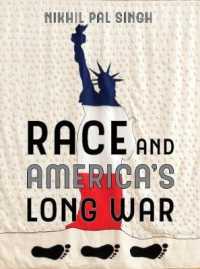- ホーム
- > 洋書
- > 英文書
- > Literary Criticism
基本説明
New readings of twelve plays: A Midsummer Night's Dream, Much Ado About Nothing, Richard 2, Henry 5, Hamlet, Othello, All's Well, The Winter's Tale, Macbeth, Measure for Measure, The Tempest, and Timon of Athens.
Full Description
This book helps the reader make sense of the most commonly studied writer in the world. It starts with a brief explanation of how Shakespeare's writings have come down to us as a series of scripts for actors in the early modern theatre industry of London. The main chapters of the book approach the texts through a series of questions: 'what's changed since Shakespeare's time?', 'to what uses has Shakespeare been put?', and 'what value is there in Shakespeare?' These questions go to the heart of why we study Shakespeare at all, which question the book encourages the readers to answer for themselves in relation to their own critical writing.Key Features* A chronology of Shakespeare's career as an actor/dramatist that locates him within the theatre industry of his time* New readings of twelve plays that form a core of the Shakespeare canon: A Midsummer Night's Dream, Much Ado About Nothing, Richard 2, Henry 5, Hamlet, Othello, All's Well that Ends Well, The Winter's Tale, Macbeth, Measure for Measure, The Tempest, and Timon of Athens* Critical analyses organized by genre (comedies, histories, tragedies, and romance) and by four key critical approaches: authorship, performance, identities, and materialism* An extensive resources section, including a glossary of the important critical terms that are often used in debates about Shakespeare
Contents
Acknowledgements; A note on style; Chronology; Introduction; How Shakespeare's works come down to us; Part One. Dramatic Genres; Chapter One. Comedies: A Midsummer Night's Dream (1595) and Much Ado About Nothing (1598); Transformation, translation, and plays to pass the time; Much Ado About Nothing; Soldiers turned lovers; Determining genre; Dirty jokes and sexual mores; Chapter Two. Histories: Richard 2 and Henry 5; This England; Providence; Serialized history and the Tudor Myth; The order of composition; What kind of king is Henry 5?; Chapter Three. Tragedies: Hamlet and Othello; Large and small affairs in Hamlet; Sex, suicide, and scepticism; Testing the supernatural; The character of Othello in isolation; The character of Othello in the world; Racial difference -- cultural difference -- multiculturalism; Chapter Four. Problem plays and Romances: All's Well that Ends Well and The Winter's Tale; Not Hamlet in a dress, nor Helen in breeches; Choosing among the men; Helen's quest; Unsuitable husbands; Do Hermione and Polixenes paddle palms?; The Winter's Tale as proto-novel; Summer/Winter -- Man/Woman -- Land/Class; Part Two. Critical Approaches; Chapter Five. Authority and authorship: Measure for Measure; History: Then; Proposing to Isabella; Being a nun; Meaning: Now; Recovering Shakespeare's version; Chapter Six. Performance: Macbeth; The witches; The timing of exits and entrances; The bipolar stage; The apparitions; Indeterminacy; Chapter Seven. Identities: The Tempest; The identity of Caliban; Nature/Nurture; The New World; Colonialism in general; Ariel as subaltern; Chapter Eight. Materialism: Timon of Athens; Base and superstructure; Timon as unaccommodated man; Money, gold, and g(u)ilt: Shakespearian alchemy; The second law of thermodynamics; The new materialism versus Gaia; Conclusion; Student Resources; Electronic Resources and Reference Resources; Glossary; Guide to Further Reading.








